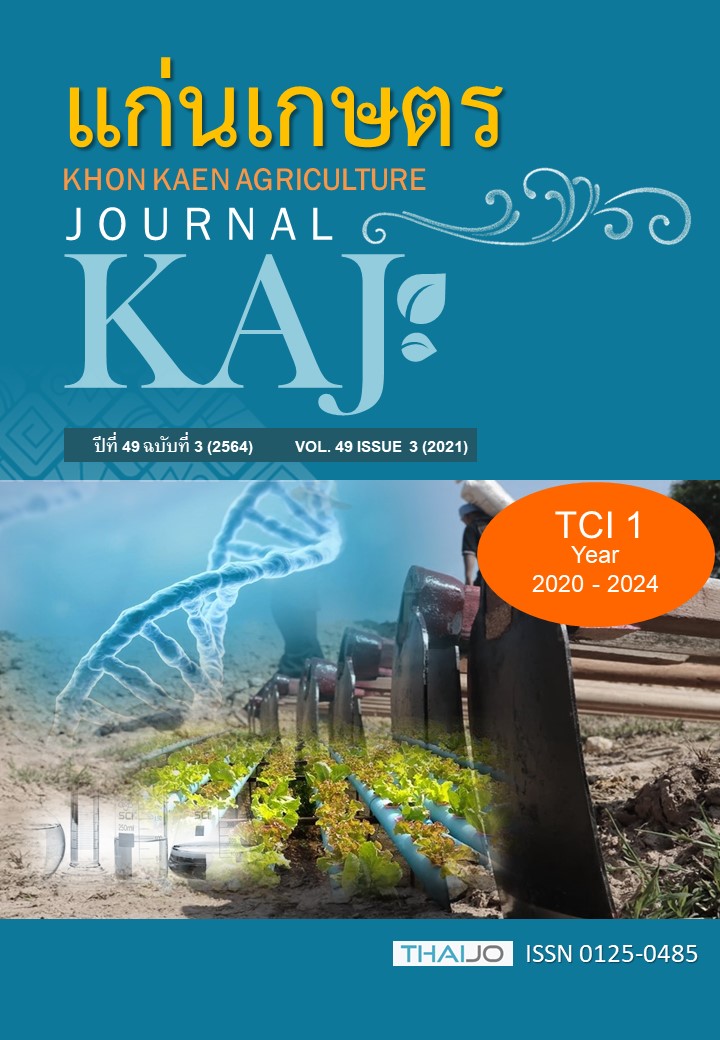การประเมินและคัดเลือกลักษณะปรากฏของพริกที่ต้านทานต่อโรคแอนแทรคโนส
Main Article Content
บทคัดย่อ
เชื้อพันธุกรรมที่ต้านทานต่อโรคแอนแทรคโนสมีความสำคัญอย่างยิ่งสำหรับการพัฒนาพริกพันธุ์ดีที่ต้านทานต่อเชื้อโรคนี้ ที่ผ่านมามีการดำเนินการรวมยีนต้านทานต่อเชื้อ Colletotrichum หลายสปีชีส์ การศึกษาครั้งนี้ มีจุดประสงค์เพื่อมุ่งประเมินสายพันธุ์พริกที่ต้านทานต่อโรคแอนแทรคโนส และมีลักษณะทางการเกษตรที่ดี โดยประเมินพริก 11 สายพันธุ์ที่ ได้รับการถ่ายทอดยีนต้านทานจากฐานพันธุกรรมที่ต่างกัน 2 แหล่ง คือ PBC932 และ PBC80 ทำการประเมินลักษณะความต้านทานต่อโรคแอนแทรคโนสในสภาพห้องปฏิบัติการ โดยปลูกเชื้อ C. capsici และ C. acutatum ที่ระยะผลสุกแก่ 2 ระยะคือ ระยะผลเขียว 35 วัน และระยะผลแดง 45 วัน หลังดอกบาน พร้อมทั้งประเมินลักษณะผลผลิต และองค์ประกอบผลผลิตในสภาพแปลง เปรียบเทียบกับพันธุ์อ่อนแอ พันธุ์ต้านทาน และพันธุ์การค้าชนิดละ 1 พันธุ์ ในฤดูฝน พ.ศ. 2561 (มิถุนายน ถึง เดือนตุลาคม) เมื่อพิจารณาลักษณะความต้านทานโรคร่วมกับการให้ผลผลิต พบว่า พริก 3 สายพันธุ์ ได้แก่ สายพันธุ์ KKU-P11221, KKU-P11235 และ KKU-P11211 เป็นสายพันธุ์ที่มีลักษณะตรงตามความต้องการ โดยพริกสายพันธุ์ KKU-P11221 แสดงความต้านทานต่อเชื้อทั้งสองสปีชีส์ ที่ 2 ระยะผลสุกแก่ สายพันธุ์ KKU-P11235 แสดงความต้านทานต่อเชื้อ C. capsici ที่ระยะผลเขียว และ C. acutatum ที่ 2 ระยะผลสุกแก่ และสายพันธุ์ KKU-P11211 แสดงความต้านทานต่อเชื้อทั้งสองสปีชีส์ ที่ระยะผลเขียว และมีลักษณะที่ใกล้เคียงกับพันธุ์การค้า ดังนั้นพริก 3 สายพันธุ์ข้างต้น เป็นสายพันธุ์พริกที่มีศักยภาพที่ดีทั้งด้านความสามารถในการต้านทานต่อโรค และการให้ผลผลิต จึงมีความเหมาะสมที่จะนำไปพัฒนาให้เป็นพริกพันธุ์ต้านทานและมีผลผลิตที่สูงขึ้นต่อไป
Article Details

อนุญาตภายใต้เงื่อนไข Creative Commons Attribution-NonCommercial-NoDerivatives 4.0 International License.
เอกสารอ้างอิง
พัชราภรณ์ สุวอ, พวงเพชร พิมพ์จันทร์, วีระ คำวอน, พวงเพ็ญ พรไธสง, คะนึงนิจ ฤทธิ์, และสุชีลา เตชะวงค์เสถียร. 2553. ลักษณะประจำพันธุ์ พริกพันธุ์ปรับปรุงของ มหาวิทยาลัยขอนแก่น จำนวน 8 พันธุ์. วารสารวิทยาศาสตร์เกษตร.
วันวิสา ใจราช, พัชราภรณ์ สุวอ, ชุมพล เตมียสถิต, และ สุชีลา เตชะวงค์เสถียร. 2557. ผลของเทคโนโลยีการผลิตที่มีต่อปริมาณและคุณภาพพริกเพื่ออุตสาหกรรมอาหาร. แก่นเกษตร. 42: 772-777.
สุชีลา เตชะวงค์เสถียร. 2557. พริก: นวัตกรรม จากทฤษฎีการปรับปรุงพันธุ์พืชสู่การใช้ประโยชน์. คลังนานาวิทยา, ขอนแก่น.
สุชีลา เตชะวงค์เสถียร. 2557. พริกยอดสนเข็ม 80: จากพริกพันธุ์พื้นบ้านสู่การใช้ประโยชน์ในอุตสาหกรรมยา. แก่นเกษตร. 42: 147-152.
AVRDC. 1999. Off-season tomato, pepper, and eggplant. In AVRDC Report 1998. Taiwan.
Black, L., and T. C. Wang. 2007. Chili Anthracnose Research at AVRDC 1993–2002. In: Abstract of The First International Symposium on Chili Anthracnose September 17–19, 2007, Convention Center, Seoul National University, Republic of Korea.
Hasanuzzman, H., and F. Golam. 2011. Gene action involved in yield and yield contributing traits of chili (Capsicum annuum L.). Australian Journal of Crop Science. 5: 1868-1875.
Henz, G. P., A. Reis, A. C. Cafe´Filho, and L. S. Boiteux. 2007. Present Situation of the anthracnose disease in sweet and hot pepper in Brazil and search for sources of resistance. In: Abstract of The First International Symposium on Chili Anthracnose. September 17–19, 2007, Convention Center, Seoul National University, Republic of Korea.
Le, D. D., T. V. Tran, T. P. V. Trinh, and T. M. K. Pham. 2007. Colletotrichum spp. attacking on chili pepper growing in Vietnam. In: Abstract of The First International Symposium on Chili Anthracnose. September 17–19, 2007, Convention Center, Seoul National University, Republic of Korea.
Liao, C. Y., M. Y. Chen, and Y. K. Chen. 2012. Characterization of three Colletotrichum acutatum isolates from Capsicum spp. European Journal of Plant Pathology. 133: 599–608.
Mahasuk, P., N. Khumpeno, S. Wasee, P. W. J. Taylor, and O. Mongkolporn. 2009. Inheritance of resistance to anthracnose (Colletotrichum capsici) at seedling and fruiting stages in chili pepper (Capsicum spp.). Plant Breeding. 128: 701-706.
Mongkolporn, O., P. Montri, T. Supakaew, and P. W. J. Taylor. 2010. Differential reaction on mature green and ripe chili fruit infected by three Colletotrichum spp. Plant Disease Journal. 94: 306-310.
Montri, P., P. W. D. Taylor, and O. Mongkolporn. 2009. Pathotypes of Colletotrichum capsici, the causal agent of chilli anthracnose, in Thailand. Plant Disease. 93: 17-20.
Ramachandran, N., R. K. Madhavi, and K. Rathnamma. 2007. Current status of chili anthracnose in India. In: Abstract of The First International Symposium on Chili Anthracnose. September 17–19, 2007, Convention Center, Seoul National University, Republic of Korea.
Saxena, A., R. Raghuwanshi, and H. B. Singh. 2016. Elevation of defense network in chilli against Colletotrichum capsici by phyllospheric Trichoderma strain. Journal of Plant Growth Regulation. 35: 377–389.
Suwor, P., P. Thummabenjapone, J. Sanichon, S. Kumar, and S. Techawongstien. 2015. Phenotypic and genotypic responses of chili (Capsicum annuum L.) progressive lines with different resistant genes against anthracnose pathogen (Colletotrichum spp.). European Journal of Plant Pathology. 143: 725-736.
Taylor, P. W. J., O. Mongkolporn, P. P. Than, P. Montri, N. Ranathunge, C. Kanchana-udomkan, R. Ford, S. Pongsupasamit, and K. D. Hyde. 2007. Pathotypes of Colletotrichum spp. infecting chilli peppers and mechanisms of resistance. In: Abstract of The First International Symposium on Chili Anthracnose. September 17–19, 2007, Convention Center, Seoul National University, Republic of Korea.
Than, P. P., R. Jeewon, K. D. Hyde, S. Pongsupasamit S, O. Mongkolporn, and P. W. J. Taylor. 2008. Characterization and pathogenicity of Colletotrichum species associated with anthracnose disease on chili (Capsicum ssp.) in Thailand, Plant Pathology. 57: 562-572.
Wang, Y. W. 2011. Development of sequence characterized amplified region (SCAR) markers associated with pepper anthracnose (Colletotrichum acutatum) resistance. Master’s Thesis, Department of Agronomy, National Chiayi University, Chiayi, Taiwan.
Yoon, J. B., D. C. Yang, W. P. Lee, S. Y. Ahn and H. G. Park. 2004. Genetic resources resistant to anthracnose in the genus Capsicum. Korean Journal of Horticultural Science and Technology. 45: 318-323.
Zhang, D., C. Zhu, and Y. Liu. 2007. Chili anthracnose research in China: An Overview. In: Abstract of The First International Symposium on Chili Anthracnose. September 17–19, 2007, Convention Center, Seoul National University, Republic of Korea.


